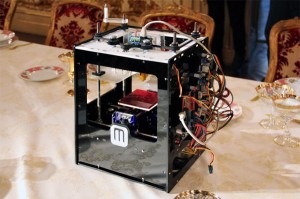Mai 11, 2012
“Let Them Print Cake” Artikel zum Thema 3D Print
Architizer News
Let Them Print Cake
April 27, 2012

Increasing in popularity and decreasing in cost, 3D printing technology has been appropriated from the industrial sector by DIY communities and repurposed for various uses other than rapid prototyping, from mass customization of frivolous knickknacks to the creation of intricate jewelry. As part of “The Future in the Making,” a recent exhibition organized by Italian design magazine Domusand Audi for Milan Design Week, Spanish architecture studio GGLab and designer Deniz Manisali showed off their method of applying additive manufacturing technology to haute cuisine.
Working with chef Paco Morales and the Institute for Advanced Architecture of Catalonia (IAAC), the team outfitted a MakerBot—a low-cost, open-source 3D printer with an impressively industrious marketing and PR team—to print a collection of diverse, formally complex chocolate sweets. This highly customizable technology could loosen formal constraints on dishes and increase workflow and volume in the kitchen, but, more importantly, has the potential to foster novel, inventive considerations of ingredients, flavors and aesthetics. Although less romantic, 3D printing also has foreseeable applications in industrial food production. Continue.
With GGlab’s food printer as the jarring centerpiece of a long banquet table at the theatrical and opulent Palazzo Clerici, Domus editor-in-chief Joseph Grima mused about the place of 3D printing in the “banquet of the future.” Although seemingly incompatible, technology and haute cuisine have been agreeable bedfellows since the start of the molecular gastronomy movement; many restaurants use liquid nitrogen and binders with glamorous names like transglutaminase to add theatricality to recipes. Other groups have also previously explored 3D printed grub, including Cornell University andMIT Media Lab.
As food, design and technology come together, GGlab architect José Ramón Tramoyeres imagines a future in which taste buds can be scanned so that menus can be tailored to individual preferences. Unfortunately, that dream might not be realized, as it would ignore the interplay of smell, texture and temperature inputs, not to mention memory and emotion, that create the gustatory experience. Still, constructing Hansel and Gretel’s fairy-tale confectionary cottage may soon be an achievable goal.
http://www.architizer.com/en_us/blog/dyn/41944/let-them-print-cake/

